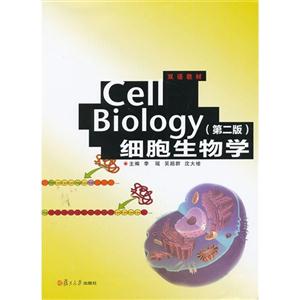-
>
宇宙、量子和人類心靈
-
>
氣候文明史
-
>
南極100天
-
>
考研數(shù)學(xué)專題練1200題
-
>
希格斯:“上帝粒子”的發(fā)明與發(fā)現(xiàn)
-
>
神農(nóng)架疊層石:10多億年前遠(yuǎn)古海洋微生物建造的大堡礁
-
>
聲音簡(jiǎn)史
細(xì)胞生物學(xué)-Cell Biology-(第二版) 版權(quán)信息
- ISBN:9787309094602
- 條形碼:9787309094602 ; 978-7-309-09460-2
- 裝幀:一般膠版紙
- 冊(cè)數(shù):暫無
- 重量:暫無
- 所屬分類:>>
細(xì)胞生物學(xué)-Cell Biology-(第二版) 本書特色
細(xì)胞生物學(xué)是一門迅猛發(fā)展的生命科學(xué)的重要基礎(chǔ)學(xué)科,有關(guān)細(xì)胞的基礎(chǔ)知識(shí)和相關(guān)研究是現(xiàn)代生命科學(xué)的基石。《細(xì)胞生物學(xué)(第2版雙語教材)》由李瑤、吳超群、沈大棱主編,本教材的目的是使大學(xué)本科學(xué)生初步掌握本課程基本內(nèi)容、基本原理、基本知識(shí),為深入學(xué)習(xí)生命科學(xué)各科奠定基礎(chǔ)。
細(xì)胞生物學(xué)-Cell Biology-(第二版) 內(nèi)容簡(jiǎn)介
《雙語教材:cell biology細(xì)胞生物學(xué)(第2版)》由復(fù)旦大學(xué)生命科學(xué)院細(xì)胞教學(xué)組牽頭,組織國內(nèi)外綜合、師范、醫(yī)學(xué)、農(nóng)林等有關(guān)院校的11位多年從事細(xì)胞和分子生物學(xué)教學(xué)及科研的教授和專家,并在美國科學(xué)院院士、著名分子細(xì)胞生物學(xué)家georgee r.stark教授直接指導(dǎo)下編寫完成。在系統(tǒng)闡述細(xì)胞各部分的結(jié)構(gòu)和功能的基礎(chǔ)上,重點(diǎn)介紹了物質(zhì)運(yùn)輸、信息傳遞、能量轉(zhuǎn)換、周期調(diào)控、分化發(fā)育、癌變、免疫、衰老與凋亡等細(xì)胞的重大生命活動(dòng)。正文全部用英語編寫,語言上做到簡(jiǎn)練與通俗,科學(xué)上做到精確與先進(jìn);既介紹細(xì)胞生物學(xué)的基本概念和基本原理,又反映各領(lǐng)域的發(fā)展前沿。為便于讀者自學(xué)并同時(shí)掌握中、英文雙語概念,各章尾附有思考題,教材的附錄為細(xì)胞生物學(xué)常用詞匯的中文解釋。
細(xì)胞生物學(xué)-Cell Biology-(第二版) 目錄
chapter 1 introduction to cell biology
1.1 what is cell biology
1.2 the cell theory
1.3 cell is the basic unit of life
1.4 diversity of cells
1.5 the prokaryotic cell
1.6 the eukaryotic cell
1.7 morden cell biology
1.8 the technology of cell biology
1.9 training the scientists of tomorrow
chapter 2 chemical components of cells
2.1 chemical bonds
2.2 organic molecules
chapter 3 biomembrane and cell surface
3.1 components and structure of biomembranes
3.2 plasma membrane
3.3 transmembrane transport
3.4 cell junction and adhesion molecules
3.5 extracellular matrix and cell wall
chapter 4 intracellular compartments and transport
4.1 organelles
4.2 protein sorting inside cell
4.3 molecular mechanisms of vesicular transport
4.4 secretory pathways
4.5 endocytic pathways
chapter 5 mitochondria and chloroplasts
5.1 mitochondria and oxidative phosphorylation
5.2 chloroplasts and photosynthesis
5.3 the origins of chloroplasts and mitochondria chapter
6 cytoskeleton
6.1 microtubules
6.2 actin filaments
6.3 intermediate filaments
chapter 7 cell communication and signaling
7. ] signaling molecules and their receptors
7.2 nitric oxide crosses the plasma membrane and activesintracellular enzymes directly
7.3 functions of cell surface receptors
7.4 signal network system
7.5 cell signaling and the cytoskeleton
7.6 cell communication in plants
chapter 8 nucleus and chromosomes
8.1 the nucleus of a eukaryotic cell
8.2 the nuclear envelope
8.3 structure of the nuclear pore complex and its role innucleocytoplasmic exchange
8.4 chromosomes and chromatin
8.5 nucleolus and ribosome biogenesis
8.6 the nuclear matrix
chapter 9 cell cycle and cell division
9.1 an overview of the cell cycle
9.2 regulation of the cell cycle
9.3 cell division
chapter 10 cell differentiation
10.1 introduction
10.2 cells with potency of differentiation
10.3 stem cells
10.4 epigenetic view of cell differentiation
10.5 the major cell differentiation systems
chapter 11 cell senescence and apoptosis
11.1 senescence
11.2 apoptosis
11.3 senescence versus apoptosis
chapter 12 cells in immune system
12.1 the immune system
12.2 the organs of the immune system
12.3 innate and adaptive immune systems
12.4 innate immune system
12.5 adaptive immune system
chapter 13 cancer cells
13.1 basic knowledge about cancer cell
13.2 carcinogenesis
13.3 the genes involved in cancer
13.4 the genetic and epigenetic changes of cancer
13.5 diagnosis and treatment of cancer
references
glossary
- >
月亮與六便士
- >
史學(xué)評(píng)論
- >
莉莉和章魚
- >
巴金-再思錄
- >
羅曼·羅蘭讀書隨筆-精裝
- >
企鵝口袋書系列·偉大的思想20:論自然選擇(英漢雙語)
- >
小考拉的故事-套裝共3冊(cè)
- >
朝聞道
















